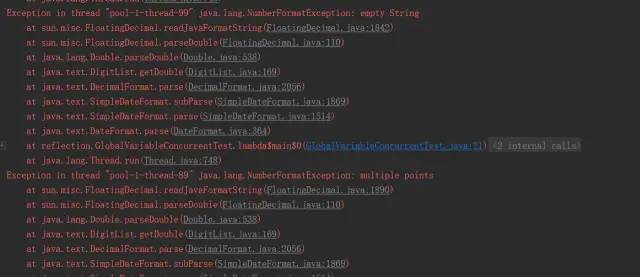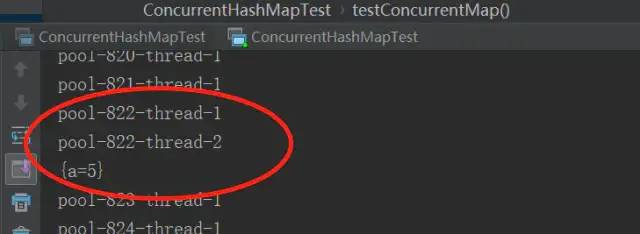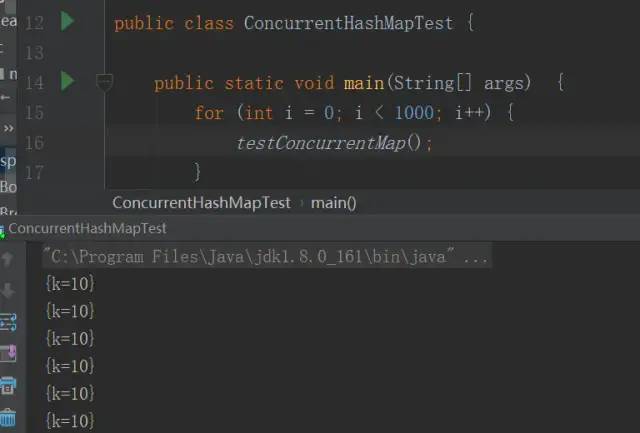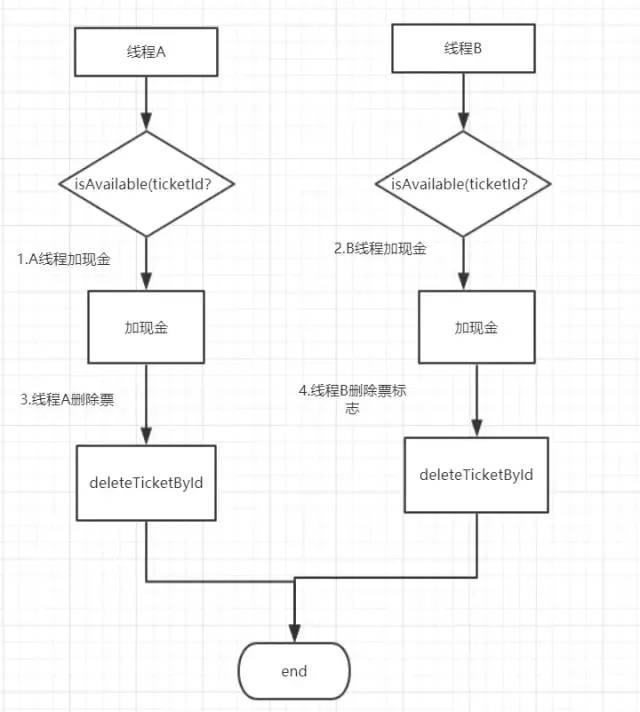日常工作中最容易犯的几个并发错误
前言
列举大家平时在工作中最容易犯的几个并发错误,都是在实际项目代码中看到的鲜活例子,希望对大家有帮助。
First Blood
线上总是出现:ERROR 1062 (23000) Duplicate entry 'xxx' for key 'yyy',我们来看一下有问题的这段代码:
UserBindInfo info = selectFromDB(userId);if(info == null){info = new UserBindInfo(userId,deviceId);insertIntoDB(info);}else{info.setDeviceId(deviceId);updateDB(info);}
在并发情况下,第一步判断都为空,就会有2个或者多个线程进入插入数据库操作, 这时候就出现了同一个ID插入多次。
正确处理姿势:
insert into UserBindInfo values(#{userId},#{deviceId}) on duplicate key update deviceId=#{deviceId}多次的情况,导致插入失败。
一般情况下,可以用insert...on duplicate key update... 解决这个问题。
注意: 如果UserBindInfo表存在主键以及一个以上的唯一索引,在并发情况下,使用insert...on duplicate key,可能会产生死锁(Mysql5.7),可以这样处理:
try{UserBindInfoMapper.insertIntoDB(userBindInfo);}catch(DuplicateKeyException ex){UserBindInfoMapper.update(userBindInfo);}
Double Kill
小心你的全局变量,如下面这段代码:
public class GlobalVariableConcurrentTest {private static final SimpleDateFormat sdf = new SimpleDateFormat("yyyy-MM-dd HH:mm:ss");public static void main(String[] args) throws InterruptedException {ThreadPoolExecutor threadPoolExecutor = new ThreadPoolExecutor(10, 100, 1, TimeUnit.MINUTES, new LinkedBlockingQueue<>(1000));while (true){threadPoolExecutor.execute(()->{String dateString = sdf.format(new Date());try {Date parseDate = sdf.parse(dateString);String dateString2 = sdf.format(parseDate);System.out.println(dateString.equals(dateString2));} catch (ParseException e) {e.printStackTrace();}});}}}
可以看到有异常抛出

全局变量的SimpleDateFormat,在并发情况下,存在安全性问题,阿里Java规约明确要求谨慎使用它。
除了SimpleDateFormat,其实很多时候,面对全局变量,我们都需要考虑并发情况是否存在问题,如下
@Componentpublic class Test {public static List<String> desc = new ArrayList<>();public List<String> getDescByUserType(int userType) {if (userType == 1) {desc.add("普通会员不可以发送和查看邮件,请购买会员");return desc;} else if (userType == 2) {desc.add("恭喜你已经是VIP会员,尽情的发邮件吧");return desc;}else {desc.add("你的身份未知");return desc;}}}
因为desc是全局变量,在并发情况下,请求getDescByUserType方法,得到的可能并不是你想要的结果。
Trible Kill
假设现在有如下业务:控制同一个用户访问某个接口的频率不能小于5秒。一般很容易想到使用redis的 setnx操作来控制并发访问,于是有以下代码:
if(RedisOperation.setnx(userId, 1)){RedisOperation.expire(userId,5,TimeUnit.SECONDS));//执行正常业务逻辑}else{return “访问过于频繁”;}
假设执行完setnx操作,还没来得及设置expireTime,机器重启或者突然崩溃,将会发生死锁。该用户id,后面执行setnx永远将为false,这可能让你永远损失那个用户。
那么怎么解决这个问题呢,可以考虑用SET key value NX EX max-lock-time ,它是一种在 Redis 中实现锁的方法,是原子性操作,不会像以上代码分两步执行,先set再expire,它是一步到位。
客户端执行以上的命令:
如果服务器返回 OK ,那么这个客户端获得锁。
如果服务器返回 NIL ,那么客户端获取锁失败,可以在稍后再重试。
设置的过期时间到达之后,锁将自动释放
Quadra Kill
我们看一下有关ConcurrentHashMap的一段代码,如下:
//全局变量Map<String, Integer> map = new ConcurrentHashMap();Integer value = count.get(k);if(value == null){map.put(k,1);}else{map.put(k,value+1);}
假设两条线程都进入 value==null,这一步,得出的结果是不是会变小?OK,客官先稍作休息,闭目养神一会,我们验证一下,请看一个demo:
public static void main(String[] args) {for (int i = 0; i < 1000; i++) {testConcurrentMap();}}private static void testConcurrentMap() {final Map<String, Integer> count = new ConcurrentHashMap<>();ExecutorService executorService = Executors.newFixedThreadPool(2);final CountDownLatch endLatch = new CountDownLatch(2);Runnable task = ()-> {for (int i = 0; i < 5; i++) {Integer value = count.get("k");if (null == value) {System.out.println(Thread.currentThread().getName());count.put("k", 1);} else {count.put("k", value + 1);}}endLatch.countDown();};executorService.execute(task);executorService.execute(task);try {endLatch.await();if (count.get("k") < 10) {System.out.println(count);}} catch (Exception e) {e.printStackTrace();}
表面看,运行结果应该都是10对吧,好的,我们再看运行结果 :

运行结果出现了5,所以这样实现是有并发问题的,那么正确的实现姿势是啥呢?
Map<K,V> map = new ConcurrentHashMap();V v = map.get(k);if(v == null){v = new V();V old = map. putIfAbsent(k,v);if(old != null){v = old;}}
可以考虑使用putIfAbsent解决这个问题
(1)如果key是新的记录,那么会向map中添加该键值对,并返回null。
(2)如果key已经存在,那么不会覆盖已有的值,返回已经存在的值
我们再来看看以下代码以及运行结果:
public static void main(String[] args) {for (int i = 0; i < 1000; i++) {testConcurrentMap();}}private static void testConcurrentMap() {ExecutorService executorService = Executors.newFixedThreadPool(2);final Map<String, AtomicInteger> map = Maps.newConcurrentMap();final CountDownLatch countDownLatch = new CountDownLatch(2);Runnable task = ()-> {AtomicInteger oldValue;for (int i = 0; i < 5; i++) {oldValue = map.get("k");if (null == oldValue) {AtomicInteger initValue = new AtomicInteger(0);oldValue = map.putIfAbsent("k", initValue);if (oldValue == null) {oldValue = initValue;}}oldValue.incrementAndGet();}countDownLatch.countDown();};executorService.execute(task);executorService.execute(task);try {countDownLatch.await();System.out.println(map);} catch (Exception e) {e.printStackTrace();}}

Penta Kill
现有如下业务场景:用户手上有一张现金券,可以兑换相应的现金,
错误示范一
if(isAvailable(ticketId){1、给现金增加操作2、deleteTicketById(ticketId)}else{return “没有可用现金券”}
解析: 假设有两条线程A,B兑换现金,执行顺序如下:

1.线程A加现金
2.线程B加现金
3.线程A删除票标志
4.线程B删除票标志
显然,这样有问题了,已经给用户加了两次现金了。
错误示范2
if(isAvailable(ticketId){1、deleteTicketById(ticketId)2、给现金增加操作}else{return “没有可用现金券”}
并发情况下,如果一条线程,第一步deleteTicketById删除失败了,也会多添加现金。
正确处理方案
if(deleteAvailableTicketById(ticketId) == 1){1、给现金增加操作}else{return “没有可用现金券”}

腾讯、阿里、滴滴后台面试题汇总总结 — (含答案)
面试:史上最全多线程面试题 !
最新阿里内推Java后端面试题
JVM难学?那是因为你没认真看完这篇文章

关注作者微信公众号 —《JAVA烂猪皮》
了解更多java后端架构知识以及最新面试宝典


看完本文记得给作者点赞+在看哦~~~大家的支持,是作者源源不断出文的动力
